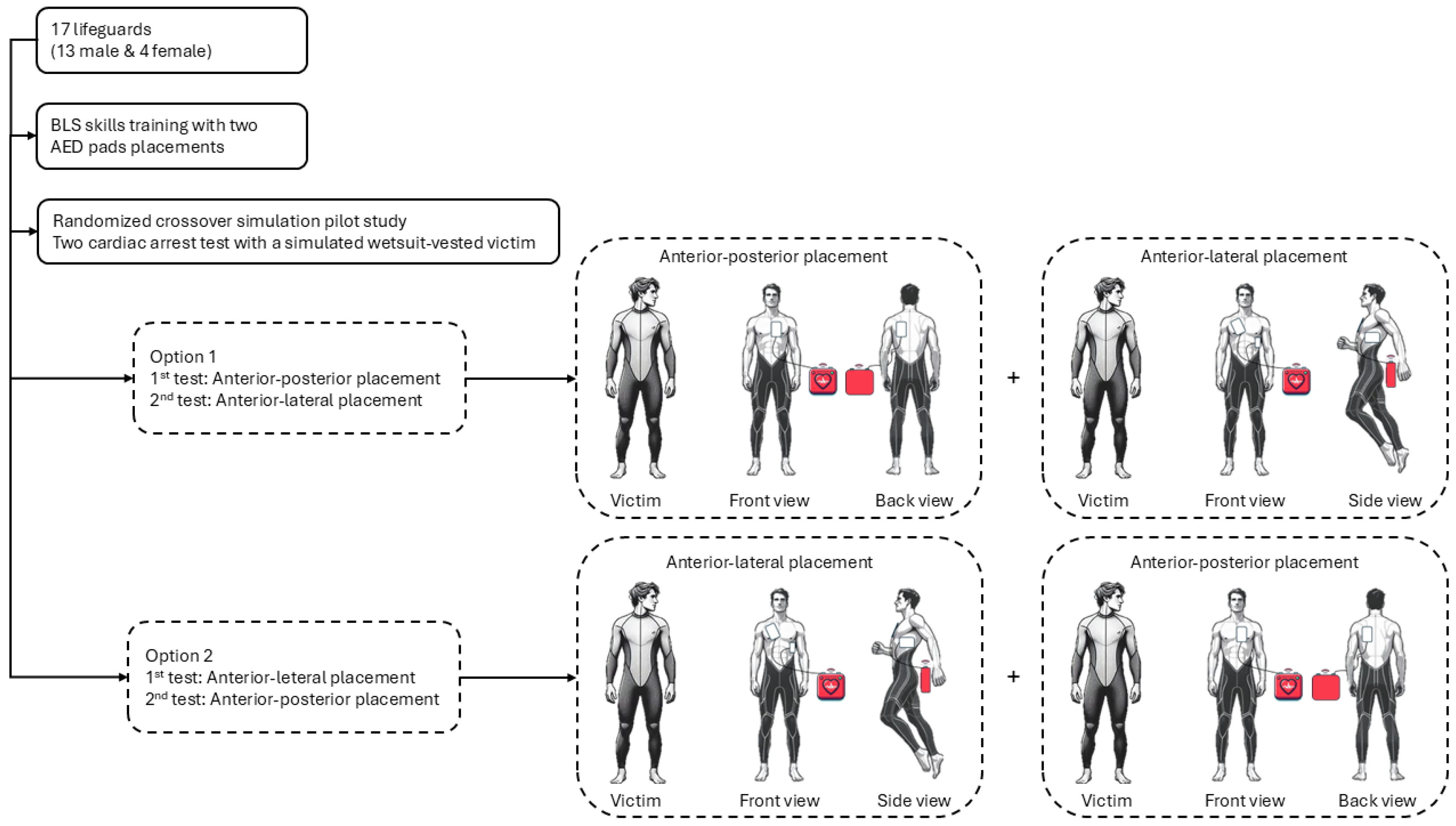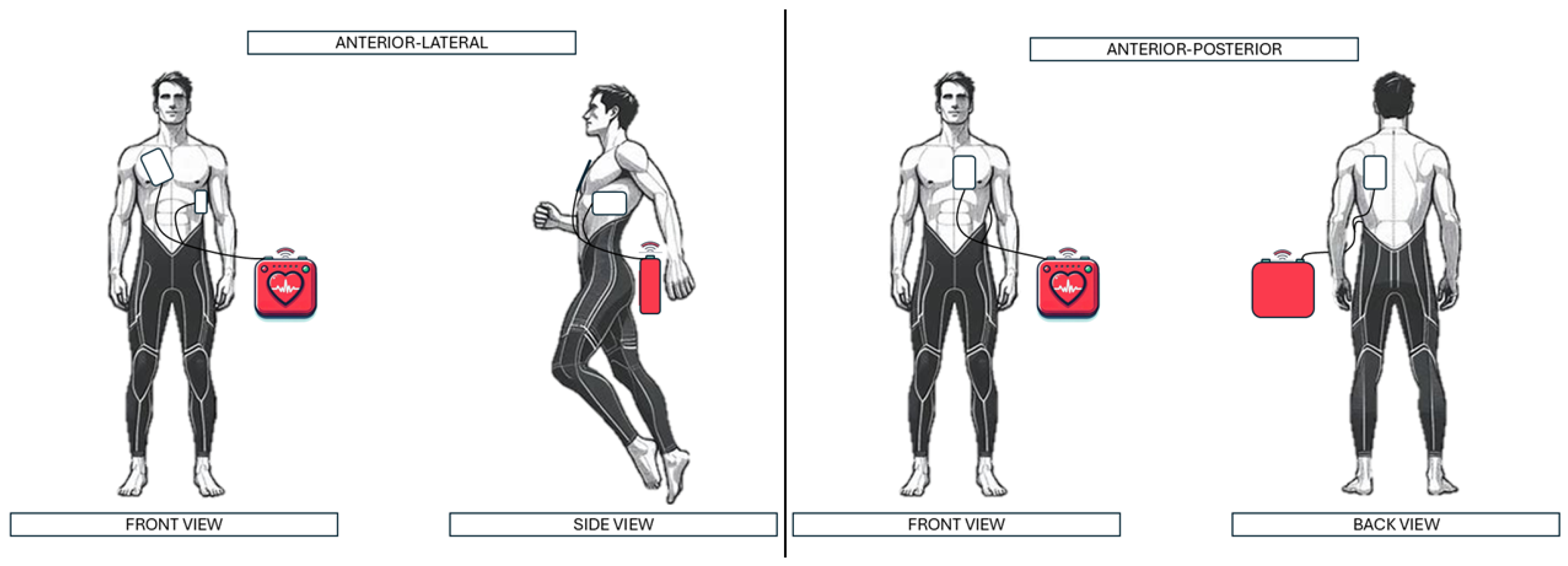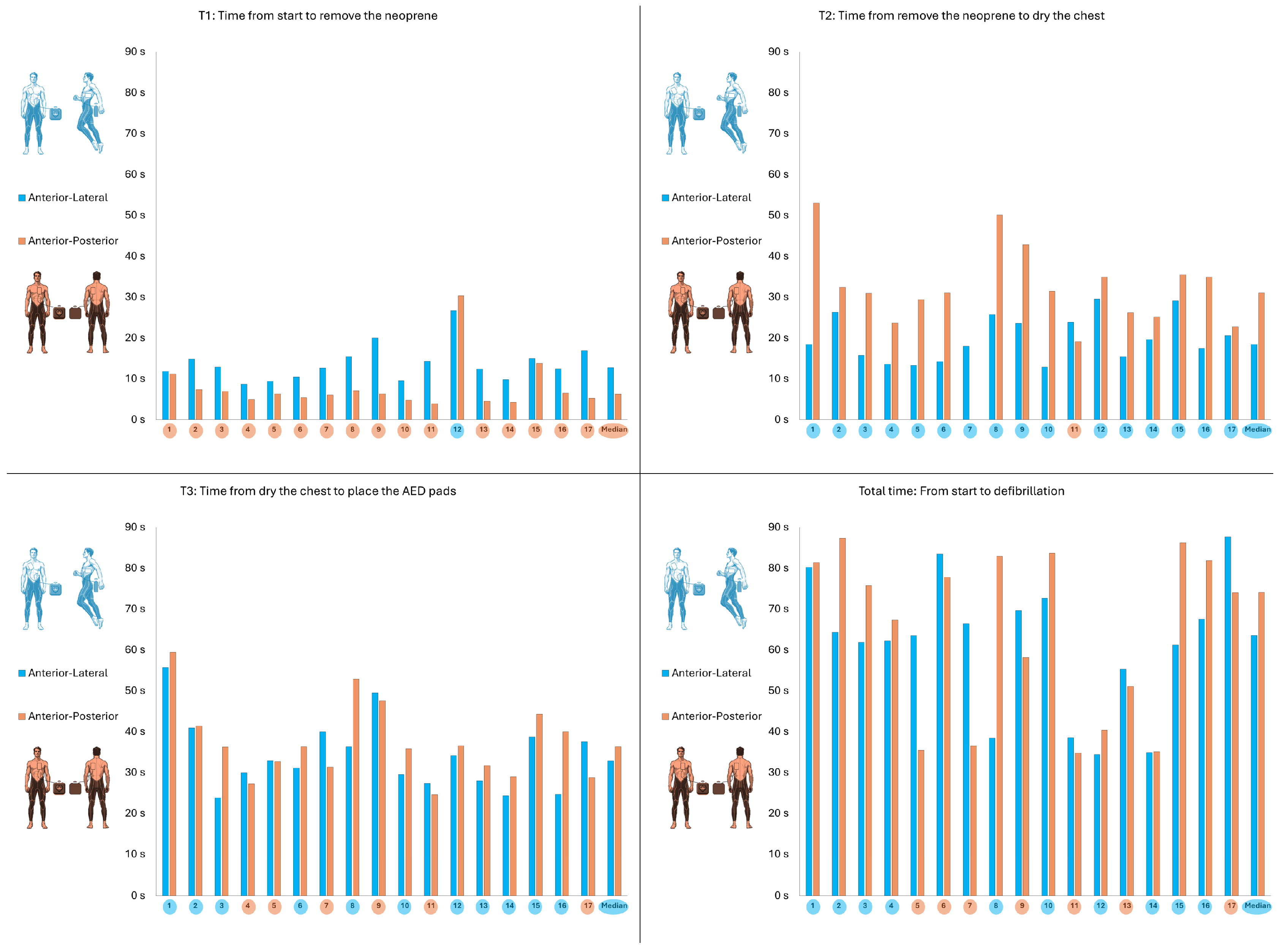Prehospital Defibrillation Challenges in Victims Wearing Wetsuits: A Pilot Comparison of AED Pad Placement Strategies
Abstract
1. Introduction
2. Materials and Methods
2.1. Sample
2.2. Previous Skills Training
2.3. Study Design
2.4. Variables
- a.
- Demographic variables: Baseline demographic characteristics were collected prior to the simulation, including age, sex, height, and weight. Body mass index (BMI) was calculated from these measurements.
- b.
- AED variables: The duration of each step involved in the AED application sequence was recorded in seconds, from the start of the scenario to the delivery of simulated defibrillation. The process was divided into the following segments:
- -
- T1: From the start of the scenario to the point at which the wetsuit was sufficiently removed to allow drying of the chest and placement of the AED electrodes.
- -
- T2: From the end of T1 to proper drying of the skin, necessary to ensure effective electrode adhesion and electrical conductivity.
- -
- T3: From the end of T2 to the placement of the AED electrodes in the assigned position.
- -
- Total time: From the beginning of the simulation to the delivery of effective defibrillation, representing the cumulative duration of all critical steps.
- c.
- Perceived fatigue and difficulty variables: After each test, participants rated the difficulty of electrode placement on an ordinal scale from 0 (no difficulty) to 10 (extreme difficulty), reflecting their subjective perception of the complexity involved in the assigned position. Additionally, following each attempt, participants reported their level of physical exertion using a modified Borg scale [11], providing a standardized measure of fatigue associated with the procedure.
2.5. Statistical Analysis
3. Results
3.1. Demographic Variables
3.2. AED Variables
3.3. Perceived Fatigue and Difficulty Variables
4. Discussion
5. Conclusions
Supplementary Materials
Author Contributions
Funding
Institutional Review Board Statement
Informed Consent Statement
Data Availability Statement
Conflicts of Interest
References
- Kitamura, T.; Iwami, T.; Kawamura, T.; Nagao, K.; Tanaka, H.; Hiraide, A. Nationwide Public-Access Defibrillation in Japan. N. Engl. J. Med. 2010, 362, 994–1004. [Google Scholar] [CrossRef] [PubMed]
- Semeraro, F.; Greif, R.; Böttiger, B.W.; Burkart, R.; Cimpoesu, D.; Georgiou, M.; Yeung, J.; Lippert, F.; SLockey, A.; Olasveengen, T.M.; et al. European Resuscitation Council Guidelines 2021: Systems saving lives. Resuscitation 2021, 161, 80–97. [Google Scholar] [CrossRef] [PubMed]
- Blom, M.T.; Beesems, S.G.; Homma, P.C.; Zijlstra, J.A.; Hulleman, M.; van Hoeijen, D.A.; Bardai, A.; Tijssen, J.G.; Tan, H.L.; Koster, R.W. Improved Survival After Out-of-Hospital Cardiac Arrest and Use of Automated External Defibrillators. Circulation 2014, 130, 1868–1875. [Google Scholar] [CrossRef] [PubMed]
- Berdowski, J.; Blom, M.T.; Bardai, A.; Tan, H.L.; Tijssen, J.G.P.; Koster, R.W. Impact of Onsite or Dispatched Automated External Defibrillator Use on Survival After Out-of-Hospital Cardiac Arrest. Circulation 2011, 124, 2225–2232. [Google Scholar] [CrossRef] [PubMed]
- Sunde, K. Sudden cardiac arrest during sports. Eur. Heart J. 2013, 34, 3596–3598. [Google Scholar] [CrossRef] [PubMed][Green Version]
- Szpilman, D.; Orlowski, J.P. Sports related to drowning. Eur. Respir. Rev. 2016, 25, 348–359. [Google Scholar] [CrossRef] [PubMed]
- Yao, Y.; DiNenna, M.A.; Chen, L.; Jin, S.; He, S.; He, J. Hypothesized mechanisms of death in swimming: A systematic review. BMC Sports Sci. Med. Rehabil. 2024, 16, 6. [Google Scholar] [CrossRef] [PubMed]
- Perkins, G.D.; Graesner, J.T.; Semeraro, F.; Olasveengen, T.; Soar, J.; Lott, C.; Van de Voorde, P.; Madar, J.; Zideman, D.; Mentzelopoulos, S.; et al. European Resuscitation Council Guidelines 2021: Executive summary. Resuscitation 2021, 161, 1–60. [Google Scholar] [CrossRef] [PubMed]
- Dreyfuss, A.; Carlson, G.K. Defibrillation in the Cardiac Arrest Patient. Emerg. Med. Clin. North Am. 2023, 41, 529–542. [Google Scholar] [CrossRef] [PubMed]
- Lupton, J.R.; Newgard, C.D.; Dennis, D.; Nuttall, J.; Sahni, R.; Jui, J.; Neth, M.R.; Daya, M.R. Initial Defibrillator Pad Position and Outcomes for Shockable Out-of-Hospital Cardiac Arrest. JAMA Netw. Open. 2024, 7, e2431673. [Google Scholar] [CrossRef] [PubMed]
- Borg, G.A. Psychophysical bases of perceived exertion. Med. Sci. Sports Exerc. 1982, 14, 377–381. [Google Scholar] [CrossRef] [PubMed]
- Cohen, J. Statistical Power Analysis for the Behavioral Sciences; Routledge: Oxfordshire, UK, 2013; 579p. [Google Scholar]
- Rosenthal, R. Meta-Analytic Procedures for Social Research; SAGE: Thousand Oaks, CA, USA, 1991; 172p. [Google Scholar]
- Cheskes, S.; Verbeek, P.R.; Drennan, I.R.; McLeod, S.L.; Turner, L.; Pinto, R.; Feldman, M.; Davis, M.; Vaillancourt, C.; Morrison, L.J.; et al. Defibrillation Strategies for Refractory Ventricular Fibrillation. N. Engl. J. Med. 2022, 387, 1947–1956. [Google Scholar] [CrossRef] [PubMed]
- Ristagno, G.; Yu, T.; Quan, W.; Freeman, G.; Li, Y. Comparison of defibrillation efficacy between two pads placements in a pediatric porcine model of cardiac arrest. Resuscitation 2012, 83, 755–759. [Google Scholar] [CrossRef] [PubMed]
- Virk, S.A.; Rubenis, I.; Brieger, D.; Raju, H. Anteroposterior Versus Anterolateral Electrode Position for Direct Current Cardioversion of Atrial Fibrillation: A Meta-Analysis of Randomised Controlled Trials. Heart Lung Circ. 2022, 31, 1640–1648. [Google Scholar] [CrossRef] [PubMed]
- Dezfulian, C.; McCallin, T.E.; Bierens, J.; Dunne, C.L.; Idris, A.H.; Kiragu, A.; Mahgoub, M.; Shenoi, R.P.; Szpilman, D.; Terry, M.; et al. 2024 American Heart Association and American Academy of Pediatrics Focused Update on Special Circumstances: Resuscitation Following Drowning: An Update to the American Heart Association Guidelines for Cardiopulmonary Resuscitation and Emergency Cardiovascular Care. Circulation 2024, 150, e501–e516. [Google Scholar] [CrossRef] [PubMed]
- Davis, C.A.; Schmidt, A.C.; Sempsrott, J.R.; Hawkins, S.C.; Arastu, A.S.; Giesbrecht, G.G.; Cushing, T.A. Wilderness Medical Society Clinical Practice Guidelines for the Treatment and Prevention of Drowning: 2024 Update. Wilderness Environ. Med. 2024, 35 (Suppl. S1), 94S–111S. [Google Scholar] [CrossRef] [PubMed]
- Panchal, A.R.; Bartos, J.A.; Cabañas, J.G.; Donnino, M.W.; Drennan, I.R.; Hirsch, K.G.; Kudenchuk, P.J.; Kurz, M.C.; Lavonas, E.J.; Morley, P.T.; et al. Adult Basic and Advanced Life Support Writing Group. Part 3: Adult Basic and Advanced Life Support: 2020 American Heart Association Guidelines for Cardiopulmonary Resuscitation and Emergency Cardiovascular Care. Circulation 2020, 142 (Suppl. 2) , S366–S468. [Google Scholar] [CrossRef] [PubMed]
- Bierens, J.; Bray, J.; Abelairas-Gomez, C.; Barcala-Furelos, R.; Beerman, S.; Claesson, A.; Dunne, C.; Fukuda, T.; Jayashree, M.; Lagina, A.T.; et al. A systematic review of interventions for resuscitation following drowning. Resusc. Plus 2023, 14, 100406. [Google Scholar] [CrossRef] [PubMed]
- Brady, W.J.; Mattu, A.; Slovis, C.M. Lay Responder Care for an Adult with Out-of-Hospital Cardiac Arrest. N. Engl. J. Med. 2019, 381, 2242–2251. [Google Scholar] [CrossRef] [PubMed]
- Abraldes, J.A.; Fernandes, R.J.; Morán-Navarro, R. Previous Intensive Running or Swimming Negatively Affects CPR Effectiveness. Int. J. Environ. Res. Public Health 2021, 18, 9843. [Google Scholar] [CrossRef] [PubMed]



| Continuous Variables | Median | IQR |
| Age (years) | 22 | (20–22) |
| Weight (kg) | 75 | (67–80) |
| Height (cm) | 174 | (170–176) |
| Body mass index (kg/m2) | 24.4 | (22.5–26.2) |
| Categorical Variables | n | (%) |
| Sex | ||
| Male | 13 | (76%) |
| Female | 4 | (24%) |
| AED Time Variables | Antero-Lateral Placement | Antero-Posterior Placement | Paired Differences and Their 95%CI | p-Value | Effect Size and Its 95%CI |
|---|---|---|---|---|---|
| T1: Time from start to remove the neoprene | 12.7 (10.4–15.0) 13.7 ± 4.5 (11.4–16.0) | 6.2 (4.9–7.1) 7.9 ± 6.3 (4.7–11.2) | Md: 5.9 (3.7–7.9) md: 5.8 (3.6–8.0) | p = 0.001 * - | r = 0.83 (0.59–0.94) - - |
| T2: Time from T1 to dry the chest | 18.4 (15.4–23.8) 19.8 ± 5.6 (17.0–22.7) | 31.0 (25.1–34.9) 30.8 ± 12.1 (24.6–37.0) | Md: −10.8 (−17.4–−5.5) md: −10.9 (−17.0–−4.8) | p = 0.004 * p = 0.002 † | r = 0.71 (0.34–0.89) d = 0.92 (0.26–1.54) |
| T3: Time from T2 to place the AED pads | 32.8 (27.9–38.7) 34.4 ± 8.8 (29.8–38.9) | 36.3 (31.3–41.4) 37.4 ± 9.37 (32.6–42.2) | Md: −3.7 (−5.6–1.9) md: −3.0 (−6.7–0.7) | p = 0.102 * p = 0.103 † | r = 0.40 (−0.10–0.74) d = 0.42 (−0.96–0.12) |
| Total time: from start to shock | 63.5 (55.2–69.6) 61.3 ± 16.4 (52.8–69.7) | 74.0 (40.4–81.8) 64.1 ± 20.7 (53.4–74.7) | Md: −1.1 (−13.9–5.7) md: −2.8 (−12.4–6.9) | p = 0.523 * - | r = 0.15 (−0.35–0.59) - - |
| Perceived Variables | Antero-Lateral Placement | Antero-Posterior Placement | Paired Differences | p-Value | Effect Size and Its 95%CI |
|---|---|---|---|---|---|
| Perceived fatigue | 1 (0–1) 0.6 ± 0.6 (0.3–0.9) | 1 (0–2) 0.8 ± 0.8 (0.4–1.3) | Md: 0.0 (0.0–0.0) md: −0.2 (−0.5–−0.1) | p = 0.046 * - | r = 0.49 (0.00–0.78) - - |
| Perceived difficulty | 1 (1–3) 2.1 ± 1.7 (1.2–2.9) | 2 (1–4) 2.8 ± 1.9 (1.8–3.8) | Md: −1.0 (−2.0–1.0) md: −0.8 (−1.7–0.1) | p = 0.096 * - | r = 0.40 (−0.10–0.74) - - |
Disclaimer/Publisher’s Note: The statements, opinions and data contained in all publications are solely those of the individual author(s) and contributor(s) and not of MDPI and/or the editor(s). MDPI and/or the editor(s) disclaim responsibility for any injury to people or property resulting from any ideas, methods, instructions or products referred to in the content. |
© 2025 by the authors. Licensee MDPI, Basel, Switzerland. This article is an open access article distributed under the terms and conditions of the Creative Commons Attribution (CC BY) license (https://creativecommons.org/licenses/by/4.0/).
Share and Cite
Santos-Folgar, M.; Otero-Agra, M.; Currás-García, D.; Fernández-Méndez, F.; Barcala-Furelos, R.; Rodríguez-Núñez, A. Prehospital Defibrillation Challenges in Victims Wearing Wetsuits: A Pilot Comparison of AED Pad Placement Strategies. J. Clin. Med. 2025, 14, 7536. https://doi.org/10.3390/jcm14217536
Santos-Folgar M, Otero-Agra M, Currás-García D, Fernández-Méndez F, Barcala-Furelos R, Rodríguez-Núñez A. Prehospital Defibrillation Challenges in Victims Wearing Wetsuits: A Pilot Comparison of AED Pad Placement Strategies. Journal of Clinical Medicine. 2025; 14(21):7536. https://doi.org/10.3390/jcm14217536
Chicago/Turabian StyleSantos-Folgar, Myriam, Martín Otero-Agra, David Currás-García, Felipe Fernández-Méndez, Roberto Barcala-Furelos, and Antonio Rodríguez-Núñez. 2025. "Prehospital Defibrillation Challenges in Victims Wearing Wetsuits: A Pilot Comparison of AED Pad Placement Strategies" Journal of Clinical Medicine 14, no. 21: 7536. https://doi.org/10.3390/jcm14217536
APA StyleSantos-Folgar, M., Otero-Agra, M., Currás-García, D., Fernández-Méndez, F., Barcala-Furelos, R., & Rodríguez-Núñez, A. (2025). Prehospital Defibrillation Challenges in Victims Wearing Wetsuits: A Pilot Comparison of AED Pad Placement Strategies. Journal of Clinical Medicine, 14(21), 7536. https://doi.org/10.3390/jcm14217536






